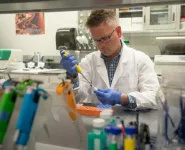(Press-News.org) HOUSTON – Several high-performance thermoelectric materials have been discovered over the past two decades, but without efficient devices to convert the energy they produce into emission-free power, their promise has been unfulfilled. Now an international team of scientists led by a University of Houston physicist and several of his former students has reported a new approach to constructing the thermoelectric modules, using silver nanoparticles to connect the modules’ electrode and metallization layers.
The work, described in a paper published May 1 in Nature Energy, should accelerate the development of advanced modules for power generation and other uses. The use of silver nanoparticles was tested for stability in modules built of three different state-of-the-art thermoelectric materials, designed to operate across a wide range of temperatures.
Thermoelectric materials have drawn increasing interest because of their potential as a source of clean energy, produced when the material converts heat – such as waste heat generated by power plants or other industrial processes – into electricity by exploiting the flow of heat current from a warmer area to a cooler area. But taking advantage of that ability requires finding a material that can connect the hot and cool sides of the material both electrically and thermally, without interfering with the material’s performance.
The connective material, or solder, is melted to create an interface between the two sides. That means the solder must have a higher melting point than the operating temperature of the device in order to remain stable while the device is working, said Zhifeng Ren, director of the Texas Center for Superconductivity at UH and a corresponding author on the paper. If the thermoelectric material operates at hotter temperatures, the connective layer will re-melt.
But it can also be a problem if the connective material has too high a melting point, because high temperatures can affect the stability and performance of the thermoelectric materials during the connection process. The ideal connective material, then, would both have a relatively low melting point for assembling the module, so as not to destabilize the thermoelectric materials, but then be able to withstand high operating temperatures without re-melting.
Silver has valuable properties for such a connective material, with high thermal conductivity and high electrical conductivity. But it also has a relatively high melting point, at 962 degrees Centigrade, which can affect the stability of many thermoelectric materials. For this work, the researchers took advantage of the fact that silver nanoparticles have a much lower melting point than bulk silver. The nanoparticles returned to a bulk state after the module was assembled, regaining the higher melting point for operations.
“If you make silver into nanoparticles, the melting point could be as low as 400 degrees or 500 degrees C, depending on the particle size. That means you can use the device at 600 C or 700 C with no problem, as long as the operating temperature remains below the melting point of bulk silver, or 962 C,” said Ren, who is also M.D. Anderson Professor of Physics at UH. He worked on the project with five former students and post-doctoral researchers from the Ren research group; they are now at the Harbin Institute of Technology in Shenzhen, China, and the Beijing National Laboratory for Condensed Matter Physics at the Chinese Academy of Sciences in Beijing.
The researchers tested the silver nanoparticles with three well-known thermoelectric materials, each of which operates at a different temperature.
A lead tellurium-based module, which works at a low temperature of about 573 Kelvin up to about 823 K (300 C to 550 C) produced a heat-to-electricity conversion efficiency of about 11% and remained stable after 50 thermal cycles, according to the researchers.
They also used the silver nanoparticles as the connective material in modules using low-temperature bismuth telluride and a half-Heusler high-temperature material, indicating the concept would work for a variety of thermoelectric materials and purposes.
Different materials are used depending on the intended heat source, Ren said, to ensure the materials can withstand the applied heat. “But this paper proves that whatever the material, we can use the same silver nanoparticles for the solder as long as the applied heat does not go above 960 degrees C,” in order to remain below the melting point of bulk silver, he said.
In addition to Ren, co-authors on the paper include Li Yin, Fan Yang, Xin Bao, Zhipeng Du, Xinyu Wang, Jinxuan Cheng, Hongjun Ji, Jiehe Sui, Xingjun Liu, Feng Cao, Jun Mao, Mingyu Li and Qian Zhang, all with the Harbin Institute of Technology; Wenhua Xue with the Harbin Institute of Technology and the Beijing National Laboratory for Condensed Matter Physics; and Yumei Wang with the Beijing National Laboratory for Condensed Matter Physics.
Jiehe Sui, Feng Cao, Jun Mao, Qian Zhang and Yumei Wang are all former members of the Ren research group.
END
Silver nanoparticles spark key advance in thermoelectricity for power generation
Low melting point for nanoparticles plus high melting point of bulk silver allows thermoelectric modules to work across range of operating temperatures
2023-05-01
ELSE PRESS RELEASES FROM THIS DATE:
A new method to test cancer drug toxicity
2023-05-01
For people with cancer, chemotherapy saves lives, but for some patients, the treatment comes with a side effect—heart damage. Screening cancer drugs for cardiotoxicity has been an ongoing challenge as heart cells don’t naturally grow in a dish, requiring researchers to do this critical testing using cardiac tissue from rodent models. A new study from researchers at Cummings School of Veterinary Medicine at Tufts University and Tufts Medical Center reports that heart tissue obtained through organ donations from dogs dying of other causes are a promising platform for testing cancer drug toxicity, offering scientists a new alternative.
The ...
Webb finds water vapor, but from a rocky planet or its star?
2023-05-01
The most common stars in the universe are red dwarf stars, which means that rocky exoplanets are most likely to be found orbiting such a star. Red dwarf stars are cool, so a planet has to hug it in a tight orbit to stay warm enough to potentially host liquid water (meaning it lies in the habitable zone). Such stars are also active, particularly when they are young, releasing ultraviolet and X-ray radiation that could destroy planetary atmospheres. As a result, one important open question in astronomy is whether a rocky planet could maintain, or reestablish, an atmosphere in such a harsh environment.
To help answer that question, astronomers ...
Cannabis knocks down pain, improves sleep and lifts brain fog in cancer patients
2023-05-01
Cancer patients who use cannabis to address their symptoms have less pain and sleep better, according to new University of Colorado Boulder research. But they also experience another, unexpected, benefit: After a few weeks of sustained use, they seem to think more clearly.
“When you’re in a lot of pain, it’s hard to think,” said senior author Angela Bryan, a professor of psychology and neuroscience at CU Boulder and a cancer survivor. “We found that when patients’ pain levels came down after using cannabis for a while, their cognition got better.”
The small but groundbreaking study, published ...
Jutras Lab awarded $1.2 million to create rapid and accurate Lyme disease testing
2023-05-01
A rapid, at-home test that can diagnose acute Lyme disease? That is the goal for researcher Brandon Jutras and his team at Virginia Tech’s Fralin Life Sciences Institute.
Through the support of a recent $1.2 million multiyear therapeutic/diagnostic research tick-borne disease grant awarded by the Department of Defense, Jutras' vision may one day become a reality. This research award aims to improve patient care and quality of life for military service members, veterans, and their beneficiaries as well as the American public living with Lyme disease and other tick-borne diseases.
“Current ...
Study: Police murder of George Floyd associated with short-term spike in firearm assaults on US police officers
2023-05-01
The police murder of George Floyd sparked nationwide protests in the summer of 2020 and revived claims that public outcry over such high-profile police killings perpetuates a violent “war on cops.” In a new study, researchers assessed if and how patterns of firearm assault on police officers in the United States were influenced by the police murder of Floyd. The study found that Floyd’s murder was associated with a three-week spike in firearm assaults on police, after which the trend in such assaults dropped to levels slightly above those predicted by pre-Floyd ...
West Antarctic Ice Sheet retreated far inland, re-advanced since last Ice Age
2023-05-01
WASHINGTON — The West Antarctic Ice Sheet is melting rapidly, raising concerns it could cross a tipping point of irreversible retreat in the next few decades if global temperatures rise 1.5 to 2.0 degrees Celsius (2.7 to 3.8 degrees Fahrenheit) above preindustrial levels. New research finds that 6,000 years ago, the grounded edge of the ice sheet may have been as far as 250 kilometers (160 miles) inland from its current location, suggesting the ice retreated deep into the continent after the end of the last ice age and re-advanced before modern retreat began.
“In the last few thousand years before we started watching, ...
Young women more likely to return to the hospital in year following heart attack
2023-05-01
Young women who experience a heart attack have more adverse outcomes and are more likely to end up back in the hospital compared to men of a similar age in the year following discharge. According to a study published in the Journal of the American College of Cardiology, second heart attack and chest pain due to the heart are the most common causes of rehospitalization, but non-cardiac hospitalizations showed the most significant disparity.
“This all begins with public awareness towards preventing heart attacks and screening ...
Risk of rehospitalization in younger women after heart attack nearly double that of men
2023-05-01
Women aged 55 years and younger have nearly double the risk of rehospitalization in the year immediately after a heart attack compared to men of similar age, according to a study supported by the National Institutes of Health. Higher rates of risk factors such as obesity, heart failure, and depression among women most likely contributed to the disparity.
The findings suggest a need for closer health monitoring of the approximately 40,000 American women aged 18 to 55 years who have heart attacks each year following hospital discharge, and a better understanding of the reasons behind ...
Nuances of the forest-water connection
2023-05-01
The infrastructure that brings drinking water to homes is an investment. For millions of people, forests are part of the system behind their faucets. Over the coming decades, many forested watersheds could be lost to development, lowering water quality and raising water treatment costs, according to a new study published in the journal Science of the Total Environment.
The research team focused on the forest-water connection in the southern U.S., a complex, heterogeneous region and, unfortunately, an ideal place for studying forest loss and worsening water quality. ...
Study identifies genetic mutations that contribute to adult epilepsy
2023-05-01
Epilepsy affects approximately 1-in-26 people and the most common form, known as temporal lobe epilepsy (TLE), often cannot be adequately treated with anti-seizure medications. Patients with this form of epilepsy may require neurosurgery to provide relief from seizures. The condition’s origins and progression are not well understood, and it has been unclear if genetic mutations may contribute to TLE. A new study by investigators from Mass General Brigham, in collaboration with colleagues at Boston Children’s Hospital, sheds new light on the role of somatic mutations in TLE — DNA alterations that occur after conception — and suggests the potential ...
LAST 30 PRESS RELEASES:
Fathers’ microplastic exposure tied to their children’s metabolic problems
Research validates laboratory model for studying high-grade serous ovarian cancer
SIR 2026 delivers transformative breakthroughs in minimally invasive medicine to improve patient care
Stem Cell Reports most downloaded papers of 2025 highlight the breadth and impact of stem cell research
Oxford-led study estimates NHS spends around 3% of its primary and secondary care budget on the health impacts of heat and cold in England
A researcher’s long quest leads to a smart composite breakthrough
Urban wild bees act as “microbial sensors” of city health.
New study finds where you live affects recovery after a hip fracture
Forecasting the impact of fully automated vehicle adoption on US road traffic injuries
Alcohol-related hospitalizations from 2016 to 2022
Semaglutide and hospitalizations in patients with obesity and established cardiovascular disease
Researchers ‘listen in’ to embryo-mother interactions during implantation using a culture system replicating the womb lining
How changing your diet could help save the world
How to make AI truly scalable and reliable for real-time traffic assignment?
Beyond fragmented markets: A new framework for efficient and stable ride-pooling
Can shape priors make road perception more reliable for autonomous driving?
AI tracks nearly 100 years of aging research, revealing key trends and gaps
Innovative techniques enable Italy’s first imaging of individual trapped atoms
KIER successfully develops Korea-made “calibration thermoelectric module” for measuring thermoelectric device performance
Diversifying US Midwest farming for stability and resilience
Emphasizing immigrants’ deservingness shifts attitudes
Japanese eels, climate change, and river temperature
Pusan National University researchers discover faster, smarter heat treatment for lightweight magnesium metals
China’s 2024 Gastroenterology Report: marked progress in endoscopy quality and disease management
Pusan National University researchers uncover scalable method for ultrahigh-resolution quantum dot displays
Researchers use robotics to find potential new antibiotic among hundreds of metal complexes
Gut bacteria changes at the earliest stages of inflammatory bowel disease
Scientists develop new way to “listen in” on the brain’s hidden language
Brain research: “Pulse generators” grow and shrink as memories are formed
For teens, any cannabis use may have impact on emotional health, academic performance
[Press-News.org] Silver nanoparticles spark key advance in thermoelectricity for power generationLow melting point for nanoparticles plus high melting point of bulk silver allows thermoelectric modules to work across range of operating temperatures






